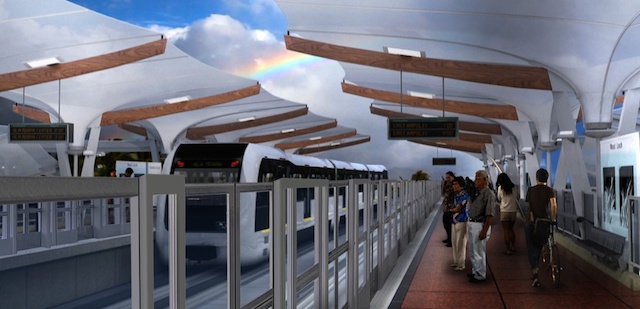Since 2011, Honolulu’s been busy building a $US5.2 billion solution to help alleviate the mind-blowing traffic congestion that’s come to define life on Oahu’s South Shore. The Honolulu Rail Transit Project is a 32km, 21-station elevated train — and it will be the first completely driverless rail system in the US.
Fully autonomous transportation has been embraced by plenty of transit systems overseas, and for good reason. Not surprisingly, computer-driven trains are far more efficient, so service is undoubtably improved. Trains can travel closer together, which means frequency is increased. And like driverless cars, the safety factor is a big one — autonomous trains will be more responsive than a human driver if something’s on the tracks and can quickly deploy proper procedures in the case of an emergency.
But when Honolulu’s robot trains start rolling in 2017, they will actually be a lonely little autonomous transit system in the US. Over at CityLab, Amy Crawford says although you’ll probably ride a driverless train at an airport near you, the idea isn’t catching on with other cities:
While many urban systems have some level of automation, including New York’s subway and the San Francisco Bay Area’s BART, right now only people-movers like the AirTrain at JFK Airport and the monorail along the Las Vegas Strip run without human operators. That’s not the case elsewhere in the world. Driverless trains have become fairly common in Asia and in Europe, where Paris automated its oldest and busiest Metro line in 2012, increasing passengers per hour by 25 per cent.
Not surprisingly, the labour issue is one factor: Cities like New York and San Francisco are known for their powerful transit unions, and it’s not gonna be easy convincing those thousands of people their services are no longer needed. But the real problem is more of a technological challenge.
Adding even some autonomous features to an existing system is cost-prohibitive for many cities with established rail networks. They simply cannot fork over that kind of cash — the entire transit system would have to be redesigned. Even though it seems to be a good investment: Honolulu’s transit authority CEO Dan Grabauskas told CityLab that operation costs over time will be significantly reduced over a human-navigated system.
So let’s review. Autonomous systems will give cities reduced costs (in the long run), better service, and improved safety — but no city wants to make the improvements necessary to make this happen. In fact, the best chance for seeing another autonomous transit network in the US would be for another city to embark upon building a brand-new system from the ground up and decide to go driverless. While we’re seeing this on most of the brand-new systems currently being built elsewhere — Riyadh’s huge system, for example, will be completely driverless — there aren’t as ambitious plans in the works for American cities right now. Honolulu’s might be the only autonomous system we see in the US for a long time. [CityLab]
